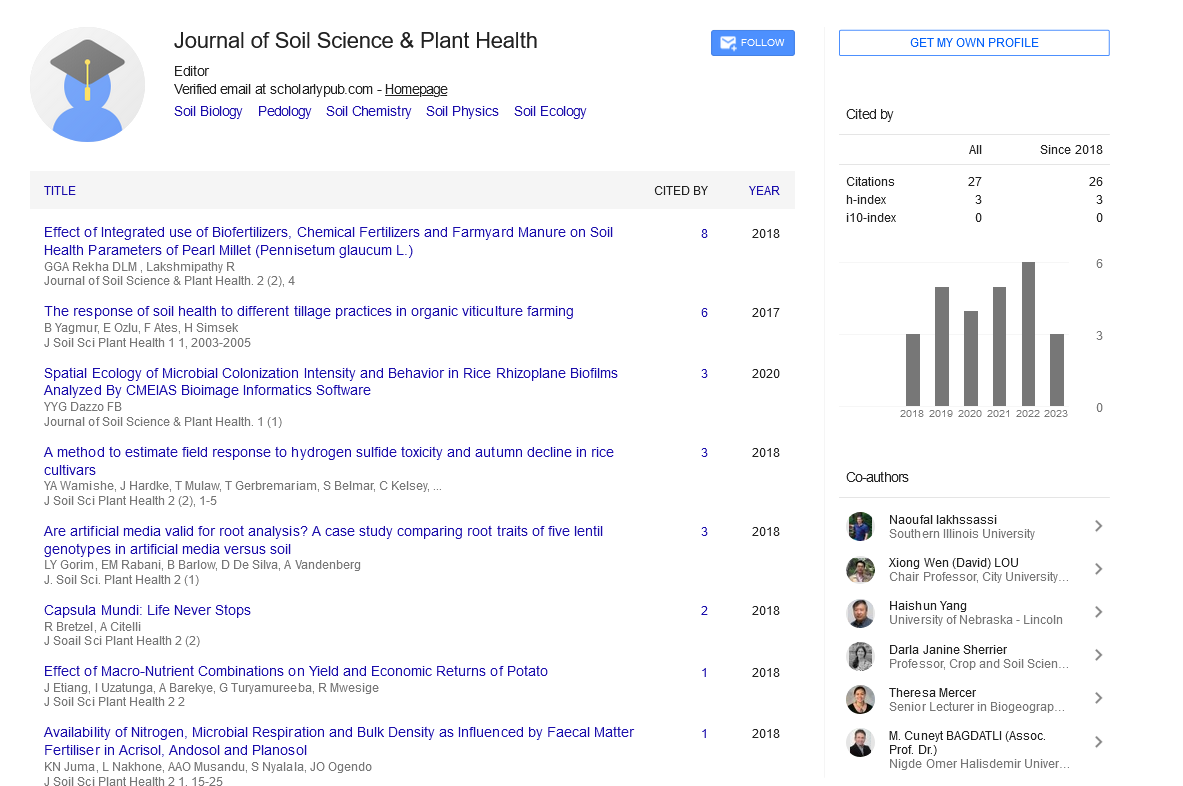Commentary, J Soil Sci Plant Health Vol: 8 Issue: 1
Impact of Climate Change on Soil Health and Plant Productivity
Rang Song*
Department of Agricultural Sciences, Ahmadu Bello Universit, Zaria, Kaduna State, Nigeria
- *Corresponding Author:
- Rang Song
Department of Agricultural Sciences,
Ahmadu Bello Universit,
Zaria,
Kaduna State,
Nigeria
E-mail: rangsong123@gmail.com
Received date: 27 October, 2023, Manuscript No. JSPH-23-118466;
Editor assigned date: 30 October, 2023, PreQC No. JSPH-23-118466 (PQ);
Reviewed date: 13 November, 2023, QC No. JSPH-23-118466;
Revised date: 05 January, 2024, Manuscript No. JSPH-23-118466 (R);
Published date: 12 January, 2024, DOI: 10.4172/jsph.1000214
Citation: Song R (2024) Impact of Climate Change on Soil Health and Plant Productivity. J Soil Sci Plant Health J 8:1.
Description
Climate change is undeniably one of the most pressing challenges of our time, with far-reaching consequences for ecosystems and human well-being. Within this multifaceted global issue, one aspect that often goes unnoticed is its impact on soil health and, by extension, plant productivity. As temperatures raise, precipitation patterns shift, and extreme weather events become more frequent, the very foundation of agriculture is being tested. Climate change is altering the dynamics of soil health and plant productivity and delves into the implications for food security and environmental sustainability.
Climate change and soil health
With rising temperatures, soil microbial activity increases. While this can accelerate nutrient cycling and decomposition, it can also deplete soil organic matter more rapidly, potentially leading to decreased soil fertility over time.
Altered precipitation patterns can lead to both drought and flooding, impacting soil moisture levels. Drought reduces water availability for plants and microorganisms, while flooding can lead to oxygen deprivation in the soil, harming aerobic organisms.
Events such as heatwaves, storms, and heavy rainfall can physically disrupt soil structures, leading to erosion and compaction. This can impede root growth and the movement of water and nutrients within the soil.
Consequences for plant productivity
Drought stress, extreme temperatures, and waterlogging can reduce crop yields. Plants may experience water stress and struggle to absorb nutrients efficiently under these conditions.
Climate change can alter the distribution and behavior of pests and pathogens, affecting plant health. Pests may expand their range, and longer growing seasons may allow for multiple generations in a single year.
Changes in soil pH and microbial communities can affect nutrient availability to plants. For instance, increased soil acidity can limit the availability of essential nutrients like calcium and magnesium.
Shifts in plant communities: As climate zones shift, the composition of plant communities may change. Some species may thrive in the new conditions, while others struggle to adapt.
Mitigation and adaptation strategies
Implementing soil conservation practices, such as reduced tillage and cover cropping, can help mitigate the effects of climate change on soil erosion, compaction, and organic matter loss.
Efficient irrigation systems and scheduling can help alleviate drought stress and optimize water use in agriculture.
Developing and selecting crop varieties that are better adapted to changing climatic conditions can enhance resilience.
Precise nutrient management, based on soil testing and climateaware strategies, can optimize nutrient use efficiency.
Integrated approaches to pest and disease management, including biological controls and resistant crop varieties, can help mitigate shifts in pest and pathogen behavior.
Climate-smart agriculture policies: Governments and international organizations should promote and incentivize climate-smart agricultural practices that prioritize soil health.
Long-term soil monitoring: Long-term soil monitoring and research are essential to track changes in soil health and develop adaptive strategies.
Interdisciplinary research: Collaborative research that combines soil science, agronomy, climate science, and ecology is crucial for a holistic understanding of the impact of climate change on soils and plants.
Conclusion
The impact of climate change on soil health and plant productivity is a pressing concern for agriculture, food security, and environmental sustainability. Climate change is altering the very foundation of our food production systems, demanding adaptive strategies, sustainable practices, and robust policies to mitigate the risks.
Understanding the intricate web of interactions between climate change, soil health, and plant productivity is a complex and ongoing endeavor. As the world continues to grapple with the realities of a warming climate, understanding and addressing these impacts is crucial for global food security and environmental sustainability. The integration of adaptation and mitigation strategies, along with sustainable agricultural practices, is essential in maintaining healthy soils and ensuring plant productivity in a changing climate. Research, monitoring, and interdisciplinary collaboration will be instrumental in developing strategies to safeguard our soils, plants, and the future of agriculture in an era of rapid climate change. It is imperative that we act swiftly and decisively to ensure the resilience of our agricultural systems in the face of a changing climate.
 Spanish
Spanish  Chinese
Chinese  Russian
Russian  German
German  French
French  Japanese
Japanese  Portuguese
Portuguese  Hindi
Hindi 